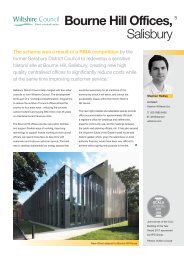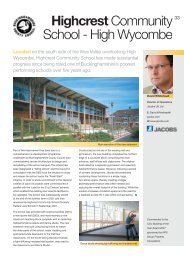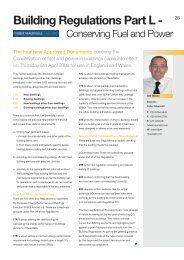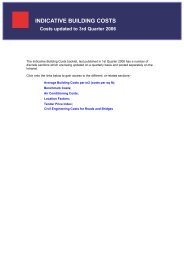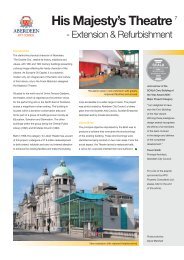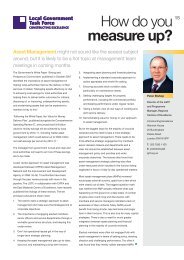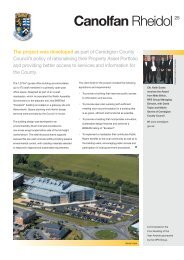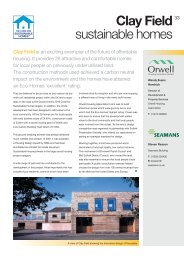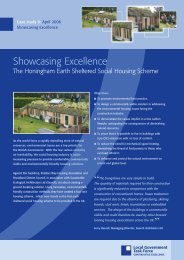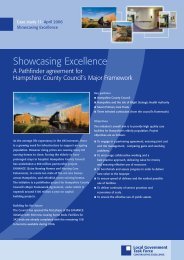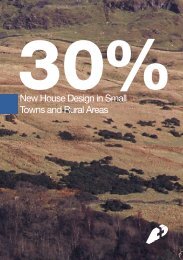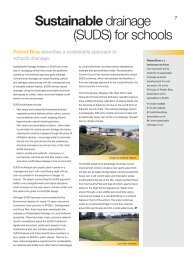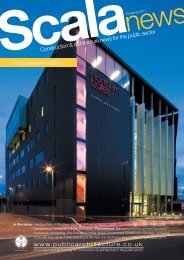cabe 1.pdf - Public Architecture.co.uk logo
cabe 1.pdf - Public Architecture.co.uk logo
cabe 1.pdf - Public Architecture.co.uk logo
You also want an ePaper? Increase the reach of your titles
YUMPU automatically turns print PDFs into web optimized ePapers that Google loves.
22<br />
News and views<br />
from the Commission for <strong>Architecture</strong><br />
& the Built Environment<br />
CABE Space - championing the public realm.<br />
Rachel Toms<br />
Programme Officer -<br />
Enabling and Delivery,<br />
CABE Space<br />
T: 020 7960 2463<br />
E: rtoms@<strong>cabe</strong>.org.<strong>uk</strong><br />
This article and the<br />
following article on<br />
Stoneleigh Park follows<br />
up on ‘The Urban<br />
Vision’ theme of SCALA<br />
2003 in October which<br />
included a presentation<br />
by Jon Rouse, Chief<br />
Executive of CABE - Ed.<br />
Urban space, as the public fabric of cities, directly<br />
influences our sense of place and the pride, dismay<br />
or dissatisfaction that we feel about our local<br />
environments. Successful parks and green spaces<br />
can <strong>co</strong>ntribute to many facets of quality of life:<br />
health and exercise, education, <strong>co</strong>mmunity<br />
interaction, <strong>co</strong>ntact with nature, play and safety.<br />
The government has now fully re<strong>co</strong>gnised that our<br />
parks and green spaces have been under-funded and<br />
subject to <strong>co</strong>nsiderable decline over the last 25 years.<br />
In 2002, the Urban Green Spaces Taskforce report<br />
Better Places, revealed that:<br />
• our parks have lost an estimated £1.3 billion of<br />
public investment since 1979<br />
• 30% of the public say they don’t use parks, usually<br />
because they feel unsafe<br />
• this figure is much higher for elderly people and<br />
those from minority ethnic groups<br />
• if you live in a deprived area, your parks are likely<br />
to be in a worse <strong>co</strong>ndition than if you live in a<br />
wealthy area<br />
• ac<strong>co</strong>rding to the most recent statistics, an<br />
estimated 56% of local authorities have no urban<br />
green space strategy<br />
• our streetscapes are in a very poor state with rigid<br />
highway engineering standards and lack of overall<br />
management <strong>co</strong>ntrol, creating hostile environments<br />
• twice as many people think their local<br />
neighbourhood has got worse rather than better in<br />
the last few years.<br />
So how do we go about achieving a real improvement<br />
in our urban spaces for the benefit of local populations?<br />
The Urban Green Spaces Taskforce found that for local<br />
authorities, the lack of a green space or open space<br />
strategy is a real barrier to having a high quality public<br />
realm. Many <strong>co</strong>uncils are preparing a host of different<br />
strategies and may be cautious about written<br />
documents potentially obscuring rather than generating<br />
action on the ground. But as the provision of high<br />
quality green space is not a statutory obligation for local<br />
authorities, a strategy can formalise priorities, clarify<br />
the need for additional funding and start to reverse the<br />
decline of urban green space. Ac<strong>co</strong>rding to authorities<br />
which have strategies in place, they help drive and<br />
focus the implementation of green space projects,<br />
improve maintenance services, secure funding and set<br />
green spaces high on the <strong>co</strong>uncil’s agenda.<br />
PPG17 defines green space through a topology list<br />
which ranges from parks and gardens to cemeteries,<br />
sports grounds and allotments. A robust strategy<br />
defines a vision for change across all types of green<br />
space within a local authority area. It <strong>co</strong>vers the<br />
provision, design, maintenance and management of<br />
green spaces and addresses <strong>co</strong>mmunity involvement<br />
in terms of defining needs and articulating aspirations.<br />
The strategy assesses supply (existing provision) and<br />
demand (population and demographics) to identify<br />
aspects for improvement and change. A green space<br />
framework and an implementation plan set out and<br />
prioritise the actions required to deliver the vision.<br />
CABE Space aims to significantly increase the number<br />
of <strong>co</strong>uncils with a green space strategy and to ensure<br />
that new strategies are robust and effective in their<br />
mandate for revitalising our parks and green spaces.<br />
Launched in May 2003, CABE Space is the Commission<br />
for <strong>Architecture</strong> and the Built Environment’s new unit to<br />
champion a high quality and successful public realm<br />
for England’s cities. The unit has been established<br />
with a remit for all urban public space, but with an<br />
initial emphasis on parks and green spaces.<br />
Guidance for local authorities producing green space<br />
strategies is being <strong>co</strong>-ordinated by CABE Space’s<br />
Enabling and Delivery programme. Its advisory<br />
scheme seeks to drive up the standard of England’s<br />
urban spaces by funding experts in public realm<br />
strategy planning, design and management to provide<br />
assistance to <strong>co</strong>uncils and other providers of public<br />
space. An advisory panel of 60 <strong>co</strong>nsultants has been<br />
established and they are currently providing 30 local<br />
authorities with between 5 and 15 days of free advice<br />
on the <strong>co</strong>ntent and production of their green space<br />
strategy. A further 60 local authorities embarking on<br />
strategies will be assisted in January and February<br />
2004 through free training days. Participants will<br />
receive guidance from the advisory panel on detailed<br />
aspects of preparing a green space strategy, such as<br />
approaches to site audit and techniques for gaining<br />
political support. A good practice guide on green<br />
space strategy preparation will be published by CABE<br />
Space in the spring.<br />
Gateshead and Harlow are both receiving assistance<br />
from the advisory scheme. Harlow’s urban fabric is<br />
likely to expand and change significantly in the future,<br />
having been identified as part of the M11 <strong>co</strong>rridor
Cabepage 23<br />
housing growth area in the Government’s Sustainable<br />
Communities programme. A strategic approach to the<br />
type, location and standard of green space is essential<br />
in ensuring that both existing and new residents have<br />
access to the best possible parks and open spaces.<br />
CABE Space has appointed two advisors to assist<br />
Gateshead Borough Council in preparing its first green<br />
space strategy. Through a substantial grant from the<br />
Heritage Lottery Fund, the <strong>co</strong>uncil has already<br />
embarked on restoring Saltwell Park, one of its finest<br />
Victorian parks. Work on the strategy will endeavour to<br />
Harlow’s green spaces are set to<br />
serve a growing population<br />
Gateshead is making plans for its parks to<br />
be<strong>co</strong>me better suited to users’ needs<br />
put this project within a strategic framework that<br />
addresses a wider range of green spaces.<br />
Advisory work during the next few months will focus<br />
on the process of auditing Gateshead’s green spaces<br />
and a stakeholder visioning workshop to explore how<br />
the city’s significant park heritage can meet<br />
increasingly diverse needs and expectations.<br />
The enabling programme and its training days are<br />
fully subscribed for this financial year although it is<br />
planned to <strong>co</strong>ntinue the scheme next year to assist<br />
more local authorities.<br />
“CABE Space aims<br />
to significantly<br />
increase the number<br />
of <strong>co</strong>uncils with a<br />
green space strategy<br />
and to ensure that<br />
new strategies are<br />
robust and effective.”<br />
CABE Space’s current programmes:<br />
Policy and Research<br />
• all of CABE Space’s work to be underpinned by<br />
empirical research and clear policy positions,<br />
aiming to demonstrate the value of parks and<br />
urban public space<br />
• three current research projects (findings to be<br />
published from spring 2004 onwards):<br />
• examination of the e<strong>co</strong>nomic value of high<br />
quality parks by looking at their beneficial impact<br />
on local residents, businesses and services<br />
• investigation into international practice for<br />
transferable lessons to improve maintenance<br />
and management<br />
• a bringing together of the wealth of existing research<br />
on the benefits of high quality urban public space<br />
Enabling and Delivery<br />
• running an advisory scheme to provide expert<br />
assistance to local authorities and other open<br />
space providers, with the aim of driving up the<br />
standard of England’s public realm; green spaces<br />
are the focus this year<br />
• offering detailed guidance to 30 local authorities<br />
preparing green space strategies<br />
• assisting a further 60 local authorities with their<br />
green space strategies through training days<br />
• green space strategy good practice guide to be<br />
published in spring 2004<br />
• providing assistance on up to 10 individual sitebased<br />
open space projects across the <strong>co</strong>untry<br />
Standards and Best Practice<br />
• publishing good practice guides with the aim<br />
of raising the standard of parks and open spaces<br />
in England<br />
• first two guides to be published in April 2004:<br />
involving young people in the design and<br />
management of urban open spaces, and a framework<br />
for the management of individual green spaces<br />
• establishing national standards to measure the<br />
quality of parks and open spaces with CABE<br />
Space’s partners, particularly through development<br />
of the Green Flag Awards Scheme<br />
Campaigns and advocacy<br />
• running campaigns in national and local media to<br />
raise aspirations for urban open space<br />
• the ‘Wasted Space?’ campaign run in autumn 2003<br />
highlighted derelict and disused urban spaces,<br />
attracting over 2,000 nominations around the <strong>co</strong>untry<br />
• a campaign is in spring 2004 will en<strong>co</strong>urage<br />
<strong>co</strong>mmunities to get involved in improving their<br />
local environment



